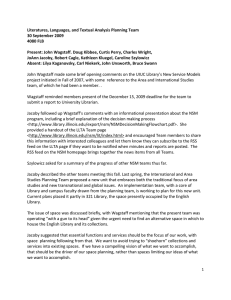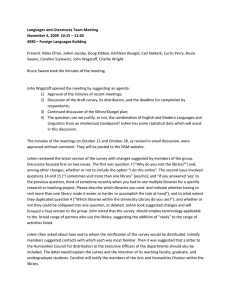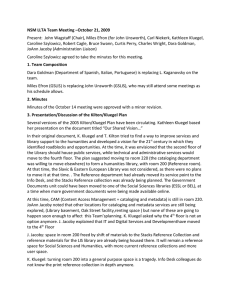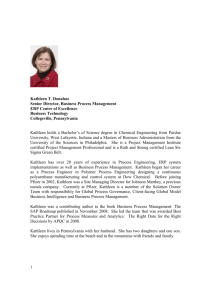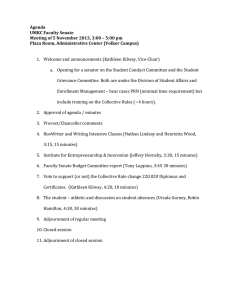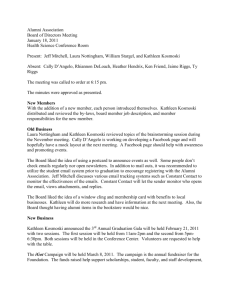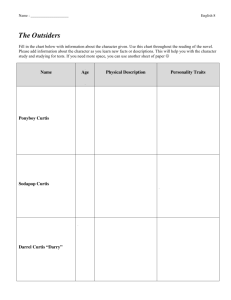LLTA NSM Team Meeting October 14, 2009
advertisement
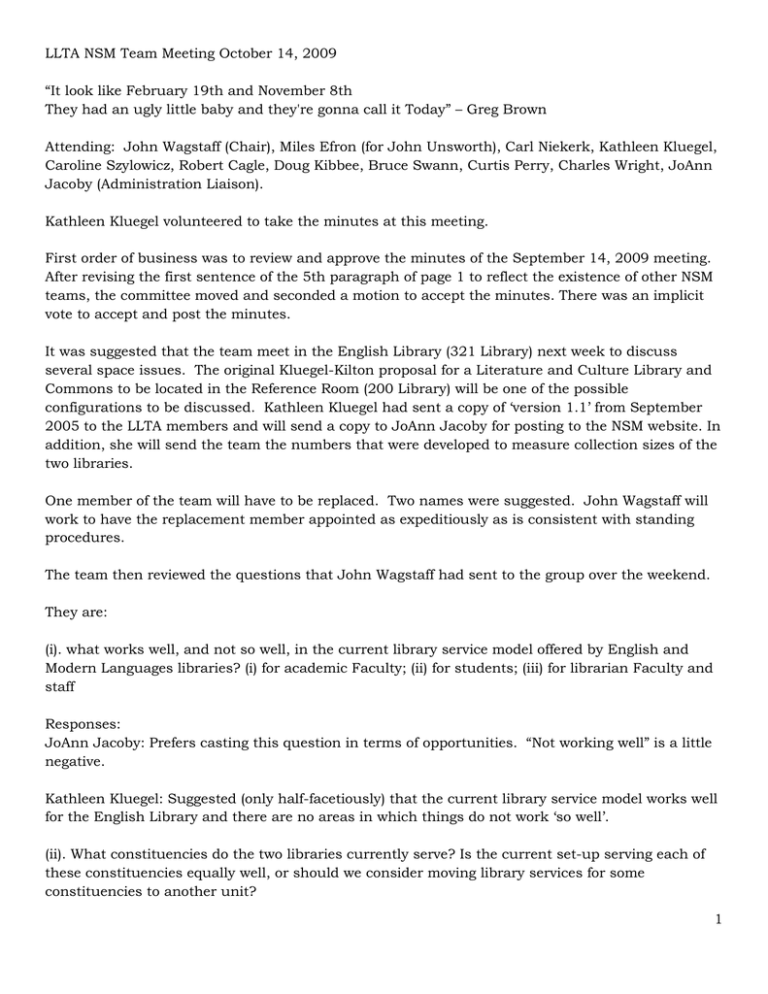
LLTA NSM Team Meeting October 14, 2009 “It look like February 19th and November 8th They had an ugly little baby and they're gonna call it Today” – Greg Brown Attending: John Wagstaff (Chair), Miles Efron (for John Unsworth), Carl Niekerk, Kathleen Kluegel, Caroline Szylowicz, Robert Cagle, Doug Kibbee, Bruce Swann, Curtis Perry, Charles Wright, JoAnn Jacoby (Administration Liaison). Kathleen Kluegel volunteered to take the minutes at this meeting. First order of business was to review and approve the minutes of the September 14, 2009 meeting. After revising the first sentence of the 5th paragraph of page 1 to reflect the existence of other NSM teams, the committee moved and seconded a motion to accept the minutes. There was an implicit vote to accept and post the minutes. It was suggested that the team meet in the English Library (321 Library) next week to discuss several space issues. The original Kluegel-Kilton proposal for a Literature and Culture Library and Commons to be located in the Reference Room (200 Library) will be one of the possible configurations to be discussed. Kathleen Kluegel had sent a copy of ‘version 1.1’ from September 2005 to the LLTA members and will send a copy to JoAnn Jacoby for posting to the NSM website. In addition, she will send the team the numbers that were developed to measure collection sizes of the two libraries. One member of the team will have to be replaced. Two names were suggested. John Wagstaff will work to have the replacement member appointed as expeditiously as is consistent with standing procedures. The team then reviewed the questions that John Wagstaff had sent to the group over the weekend. They are: (i). what works well, and not so well, in the current library service model offered by English and Modern Languages libraries? (i) for academic Faculty; (ii) for students; (iii) for librarian Faculty and staff Responses: JoAnn Jacoby: Prefers casting this question in terms of opportunities. “Not working well” is a little negative. Kathleen Kluegel: Suggested (only half-facetiously) that the current library service model works well for the English Library and there are no areas in which things do not work ‘so well’. (ii). What constituencies do the two libraries currently serve? Is the current set-up serving each of these constituencies equally well, or should we consider moving library services for some constituencies to another unit? 1 Responses (collective): The constituent departments and academic units served by the English Library and the Modern Languages and Linguistics Library include (but likely are not limited to): English, English as an International Language, French, Germanic, Scandinavian, Spanish, Italian, Portuguese, Asian American Literature, Linguistics, Center for Translation Studies, Cinema Studies, Medieval Studies, Comparative and World Literatures, American Indian Studies, Latino/Latina Studies, Media, ICR, Gender and Women’s Studies, and African American Studies. Kathleen Kluegel: Some of these constituent departments and academic units are more intrinsic to the collections and services of the English and Modern Languages and Linguistics Libraries while others have other Library units as their primary collection and service points. In addition, not all of these constituent groups have collection funds dedicated to their support. Carl Niekerk: Would incorporating the International and Area Studies libraries into the proposed English and Modern Languages merger add strength to the proposal and possibly result in larger spaces and more resources? Caroline Szylowicz: The International and Area Studies units have areas of interest that go far beyond the literature and language focus of the proposed English and Modern Languages scope. In addition, the Asian and Slavic Libraries have material almost exclusively in their respective vernaculars. John Wagstaff: While the idea of incorporating more subject areas to increase the space available might be highly desirable and feasible in a library that was in one giant square building, it is not possible in the current Main Library building. Kathleen Kluegel: Having all 11 million items of the Library in a single sequence would be her “6th circle of Hell”. Or even the 6.5 million that are in the Main Library now. It would create insurmountable challenges for everyone if they were forced to browse among and select from the full collection of the Library. For example, the Main Bookstacks have several “Great Walls o’ Shakespeare” (Dante, Milton, Cervantes, etc.) which are unusable for browsing or selecting by the vast majority of the users of the Library, however wonderful they are for the scholars of Shakespeare and the other major authors. Undergraduate users, for example, lack the experience in doing ‘on the fly’ assessments of the suitability of any particular edition of a work of Shakespeare for their immediate needs. These skills are beyond critical if they are to cope with any but a small, curated, mediated collection of his works. Robert Cagle: The role of the working collection in the English Library and the Modern Languages and Linguistics Library is why any proposal to merge the two libraries requires significant space. John Wagstaff: The International and Area Studies NSM Team is working on integrating their services and is not considering expanding their purview to literatures and linguistics. It is also important to remember, perhaps, that the libraries in the Area Studies NSM tend to collect material only in their vernacular languages rather than in the English language. Kathleen Kluegel: It is clear that there is a mis-match between budget lines and constituencies. 2 Curtis Perry: In today’s Library, there are links between program-based budgets supporting the collections and services and their respective Library units. In a future New Service Model Library there will be a need to re-examine the budget allocation assumptions and processes. Caroline Szylowicz: New programs need new Library funds. The Translation Studies Center is the first new program that requested Library funds as part of its Ed Pol proposal. In fact the Center provided startup and continuing funds for the translation studies resources. Charlie Wright: Medieval Studies was not permitted to put any number but zero in the “Library impact” part of its proposal. (iii). What advantages and disadvantages would there be to uniting the English and Modern Languages libraries in one physical space under a single unit head? [Clearly, this question will require discussion of an earlier proposal by Kathleen Kluegel and Tom Kilton to do this.] (iv). What does the team understand by the term "Textual Analysis"? What courses and constituencies is it meant to serve? And *does* it currently do so? (v). What can I-CHASS and Illinois Informatics Initiative offer to English and Modern Languages, and what can they offer to these initiatives? [We will need John Unsworth's input here.] (vi). Where would we like to see the English Library and Modern Languages Library in 10 years time? [We're supposed to try to come up with sustainable models, remember; that's the reason for this question.] (vii). Are we getting the balance right between print and electronic resources in the subjects that the team serves? If not, how could we change it? Responses: Kathleen Kluegel: As stated, this question is unanswerable. The electronic resources in the open and deep web are infinite in size. Perhaps another question was meant? Curtis Perry: The team needs to affirm its conviction of the centrality of print to the discipline of literature and textual analysis. If the question is one of allocating resources, then that will be a useful question to take up. Is the Library providing enough funds to support the print collection as well as the electronic resources needed? In addition, because support for the print collections requires space, the question must involve space as a resource. Charlie Wright: Resources – print, electronic, and space – all cost money and the money balance is the key. John Wagstaff: We are saying “print is important”, but we need to bear in mind that different patron constituencies may have different priorities. Also, that there are resources such as “Theatre on Video” which are useful in the performing arts, and surely there are examples that are more 3 relevant to English and/or Modern Languages. We also need to distinguish between electronic surrogates of pre-existing print resources, and “born digital” ones. Curtis Perry: Another university conducted a ‘print versus e-resources’ type of survey in which the demographic data on the responses were not recorded. There was perhaps a hope that the larger numbers of the undergraduates would overwhelm the faculty vote for print. However, it is important to note that while students may wish to use electronic resources for their work, I let them know they NEED to use the Library. Kathleen Kluegel: This week in the English Library there were two undergraduates with research projects that underscored the critical nature of print in their success. First, a student had looked in the online catalog and had found 5 editions of a play by Thomas Shadwell. 2 were in RBML and 3 were from EEBO. One of the e-versions had the text of the play as well as the images. But the student really wanted to use a print version because of the intellectual infrastructure that print provides. I found a print copy of the play located in the English Library by using advanced searching techniques. The second student wanted works on the N-word. Again, print sources in the English Library collection identified useful materials that were difficult to find in the catalog. Curtis Perry: The print version of the play provided editorial structures that are do not exist in the e-version. John Wagstaff: If, in the case of Kathleen’s example, there had not been a print copy of the play that was available electronically via EEBO, would the English Library have acquired one? Kathleen Kluegel: Yes. Because Thomas Shadwell is an important literary figure and because users need the structure (glosses, footnotes, context) that print provides. Charlie Wright: One cannot “get the balance right” in the abstract. Only specialists in particular fields will know what the right balance is in each field at a given time. John Wagstaff: Maybe a better question would be “Are there demands for print or electronic resources that are not being met currently?” Caroline Szylowicz: It is very challenging to get expensive electronic resources that are written in French. Most of these are multi-disciplinary in scope and it is difficult to get colleagues to share in the costs of these ‘non-English-language’ resources. Charlie Wright: Is there a role for the CIC to play in acquiring these foreign-language e-resources? John Wagstaff: It is my understanding that CIC is moving away from its previous role as negotiator for e-resources and is more focused on, for example, developing and expanding the CIC electronic repository. Curtis Perry: The questions that John Wagstaff provided for this meeting are largely philosophical or theoretical. Here is a list of questions that have a more pragmatic and practical focus: 4 A: Do we want the collections of the English Library and the Modern Languages and Linguistics Library to be merged? John Wagstaff: There is some momentum in the Library for the English Library and the Modern Languages and Linguistics Library to merge simply because of the current staffing situations in those libraries, and because of the probable loss of room 321 as English Library space. Doug Kibbee: There are personnel and staffing issues to consider. The imminent retirement of Kathleen Kluegel is among them. Curtis Perry: Next week we will meet in the English Library and discuss the Kluegel-Kilton plan that was distributed earlier. Kathleen Kluegel: I will find and send to the team the numbers we developed then that measured the size of the respective collections. John Wagstaff: There is a timeline push. The International and Area Studies ‘remodeling’ will push the English Library out. And the Modern Languages and Linguistics Library has not had a permanent, full-time head since Tom Kilton retired in 2006. The merger of the English Library and the Modern Languages and Linguistics Library might be a push for creating a permanent headship. Are there advantages to the merger other than “Realpolitik”? For example, are there any courses taught by members from both departments? Charlie Wright: There are faculty members with joint appointments and there are many courses that are cross-listed but there are very few if any that involve team teaching across departments. B: What additional resources and services would this merger need? C: How does the team reflect its ongoing commitment to print collections? D: What are the space implications of the decisions we take? E: What are the relationships between the specific collections in the English Library, the Modern Languages and Linguistics Library, and their corresponding collections in Main Bookstacks? And the relationships between those collections and the materials housed in OSSF? F: How do you bring appropriate constituencies into the process as we go? Charlie Wright: It would be useful to see how many departments have a Library committee or a Library liaison. The LLTA team member(s) could meet with these Library liaisons as one aspect of this process. JoAnn Jacoby: There is a set of questions developed by Jane Block for the Landscape Architecture faculty. And another set from the Communications team. Charlie Wright: What are the needs of these other constituencies? 5 Caroline Szylowicz: Would these questions be part of open meetings or a web survey? Curtis Perry: A web survey would produce better results. Faculty in the English Department would be unlikely to attend another open meeting on the Library. There is also an Undergrad Leadership Council in the English Department that could be of possible use in reaching undergraduates. John Wagstaff: The meetings with Library committees and liaisons could be structured around the same questions as the web survey. Curtis Perry: It is important to consider the fact that too many responses, e.g. from a widespread call to participate, would overwhelm the team’s ability to use the results. Reams of comments from open-ended questions would take much longer than we have to deal with them. JoAnn Jacoby: The team could have the help of a graduate student in compiling the responses. Miles Efron: The team will have to find a way to constrain the respondent pool. 6
